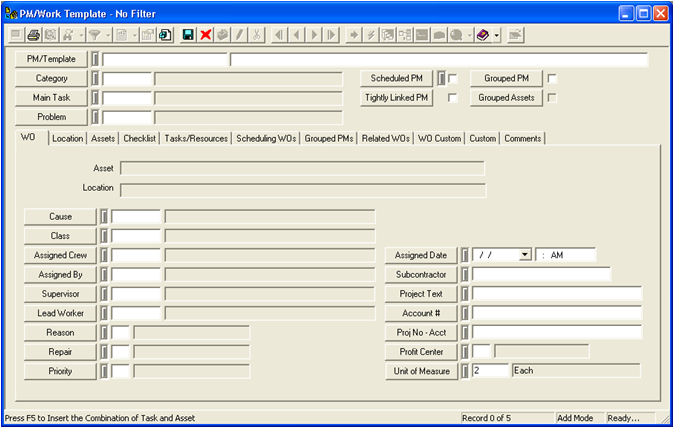The PM/Work Template module allows you to schedule preventative maintenance tasks (PMs). This module is designed to automatically generate PM work orders based on the schedule you set up in the Scheduling WOs tab or Grouped PMs tab. Below is a list of basic steps to guide you through the PM setup process.
![]() Click on this link to access the PM/Work Template Tutorial Movies.
Click on this link to access the PM/Work Template Tutorial Movies.
To create a PM, complete the following steps:
Work > PM/Work Template. The following window will appear:
 on the module toolbar to enter Add Mode.
on the module toolbar to enter Add Mode.
, enter the cause, assign a crew, etc. The Asset and Location fields are read-only fields that are auto- populated. These fields allow you to see at a glance the first asset and location listed in the corresponding grids.Note: This is a critical step. The Scheduled PM checkbox differentiates a work order template from a PM. When this box is marked, the Scheduling WO tab fields will be enabled allowing you to schedule your preventative maintenance.
Note: Once a PM is designated as scheduled, it cannot be switched to a non-scheduled work order. To disable a PM (i.e. stop it from generating work orders), change the schedule dates/readings, and remove the start and next date values when the record is in Edit Mode.
Note: A lead worker must be assigned to a work order if you want the Assigned Work field in the Work Flow Setup Employees module to calculate the number of assigned work hours for that employee.
Note: Any resources associated with a task (in the Work Flow Setup Tasks module) will be automatically populated in the Resources grid.
tab. Note: This is a critical step. The PM schedule is what differentiates a PM from a work order template.
tab. This is especially useful if you have maintenance work on multiple assets that can be performed at the same time. to save the PM.
to save the PM.Notes: Once a PM/Template is designated as a PM, it cannot be changed back to a Work Order template. A standard PM may not be converted to a Grouped PM or vice versa. A standard PM may not be converted to a Tightly Linked PM or vice versa. A Grouped PM may not be converted to a Grouped Asset PM or vice versa.